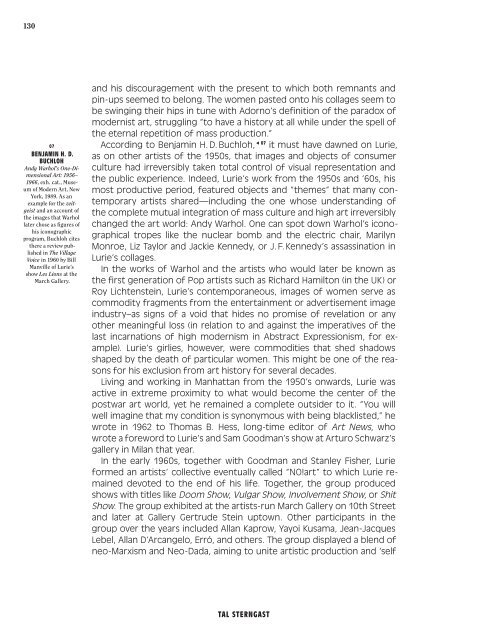The Art of
Katalog_Boris-Lurie_English
Katalog_Boris-Lurie_English
You also want an ePaper? Increase the reach of your titles
YUMPU automatically turns print PDFs into web optimized ePapers that Google loves.
130<br />
07<br />
BENJAMIN H. D.<br />
BUCHLOH<br />
Andy Warhol’s One-Dimensional<br />
<strong>Art</strong>: 1956–<br />
1966, exh. cat., Museum<br />
<strong>of</strong> Modern <strong>Art</strong>, New<br />
York, 1989. As an<br />
example for the zeitgeist<br />
and an account <strong>of</strong><br />
the images that Warhol<br />
later chose as figures <strong>of</strong><br />
his iconographic<br />
program, Buchloh cites<br />
there a review published<br />
in <strong>The</strong> Village<br />
Voice in 1960 by Bill<br />
Manville <strong>of</strong> Lurie’s<br />
show Les Lions at the<br />
March Gallery.<br />
and his discouragement with the present to which both remnants and<br />
pin-ups seemed to belong. <strong>The</strong> women pasted onto his collages seem to<br />
be swinging their hips in tune with Adorno’s definition <strong>of</strong> the paradox <strong>of</strong><br />
modernist art, struggling “to have a history at all while under the spell <strong>of</strong><br />
the eternal repetition <strong>of</strong> mass production.”<br />
According to Benjamin H. D. Buchloh, 07 it must have dawned on Lurie,<br />
as on other artists <strong>of</strong> the 1950s, that images and objects <strong>of</strong> consumer<br />
culture had irreversibly taken total control <strong>of</strong> visual representation and<br />
the public experience. Indeed, Lurie’s work from the 1950s and ’60s, his<br />
most productive period, featured objects and “themes” that many contemporary<br />
artists shared—including the one whose understanding <strong>of</strong><br />
the complete mutual integration <strong>of</strong> mass culture and high art irreversibly<br />
changed the art world: Andy Warhol. One can spot down Warhol’s iconographical<br />
tropes like the nuclear bomb and the electric chair, Marilyn<br />
Monroe, Liz Taylor and Jackie Kennedy, or J. F. Kennedy’s assassination in<br />
Lurie’s collages.<br />
In the works <strong>of</strong> Warhol and the artists who would later be known as<br />
the first generation <strong>of</strong> Pop artists such as Richard Hamilton (in the UK) or<br />
Roy Lichtenstein, Lurie’s contemporaneous, images <strong>of</strong> women serve as<br />
commodity fragments from the entertainment or advertisement image<br />
industry–as signs <strong>of</strong> a void that hides no promise <strong>of</strong> revelation or any<br />
other meaningful loss (in relation to and against the imperatives <strong>of</strong> the<br />
last incarnations <strong>of</strong> high modernism in Abstract Expressionism, for example).<br />
Lurie’s girlies, however, were commodities that shed shadows<br />
shaped by the death <strong>of</strong> particular women. This might be one <strong>of</strong> the reasons<br />
for his exclusion from art history for several decades.<br />
Living and working in Manhattan from the 1950’s onwards, Lurie was<br />
active in extreme proximity to what would become the center <strong>of</strong> the<br />
postwar art world, yet he remained a complete outsider to it. “You will<br />
well imagine that my condition is synonymous with being blacklisted,” he<br />
wrote in 1962 to Thomas B. Hess, long-time editor <strong>of</strong> <strong>Art</strong> News, who<br />
wrote a foreword to Lurie’s and Sam Goodman’s show at <strong>Art</strong>uro Schwarz’s<br />
gallery in Milan that year.<br />
In the early 1960s, together with Goodman and Stanley Fisher, Lurie<br />
formed an artists’ collective eventually called “NO!art” to which Lurie remained<br />
devoted to the end <strong>of</strong> his life. Together, the group produced<br />
shows with titles like Doom Show, Vulgar Show, Involvement Show, or Shit<br />
Show. <strong>The</strong> group exhibited at the artists-run March Gallery on 10th Street<br />
and later at Gallery Gertrude Stein uptown. Other participants in the<br />
group over the years included Allan Kaprow, Yayoi Kusama, Jean-Jacques<br />
Lebel, Allan D’Arcangelo, Erró, and others. <strong>The</strong> group displayed a blend <strong>of</strong><br />
neo-Marxism and Neo-Dada, aiming to unite artistic production and ‘self<br />
TAL STERNGAST



